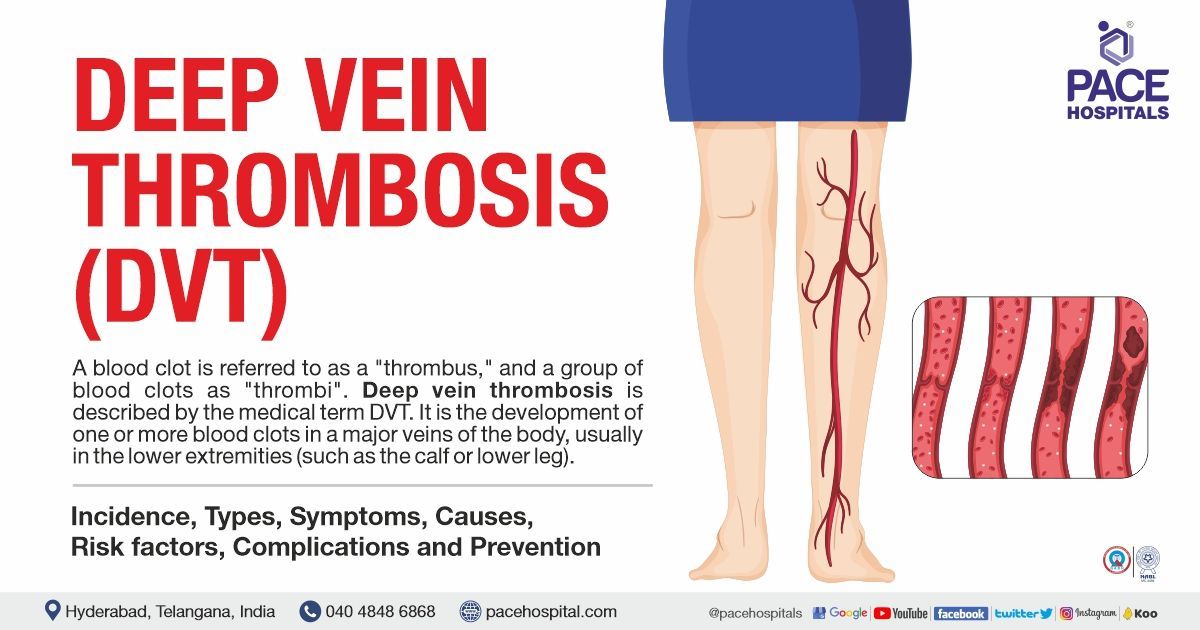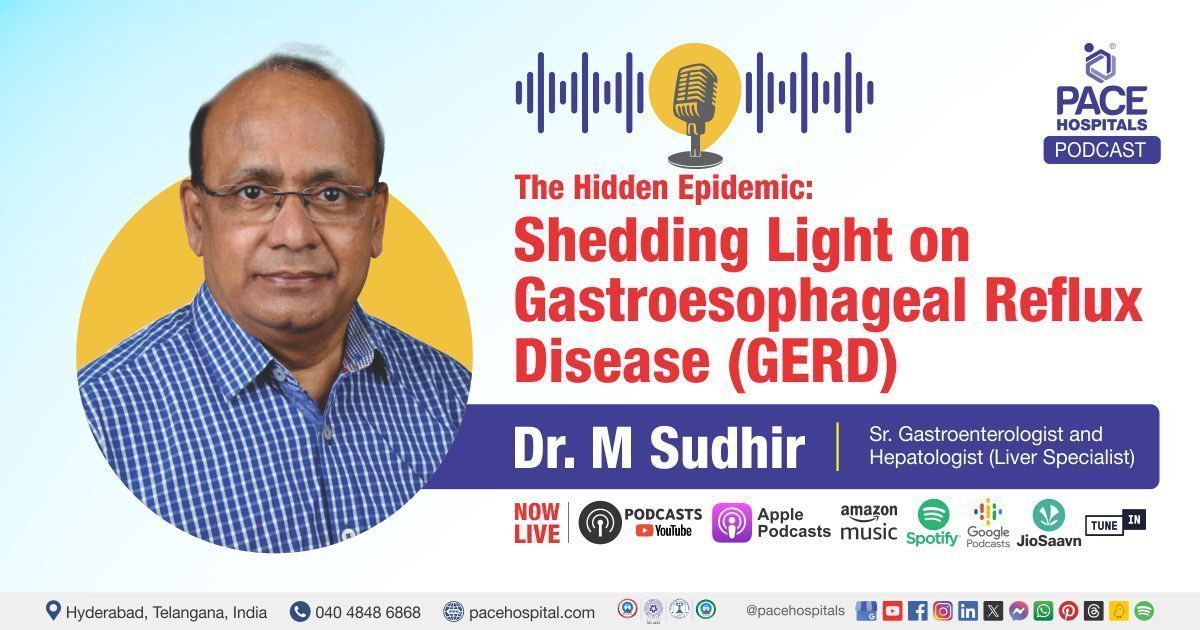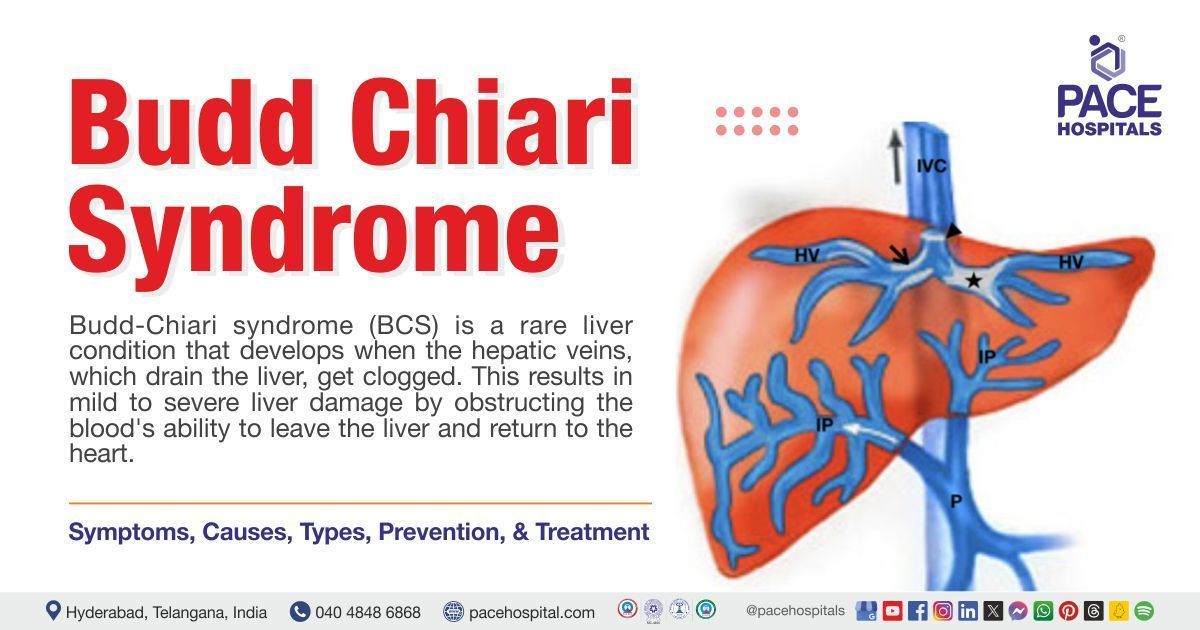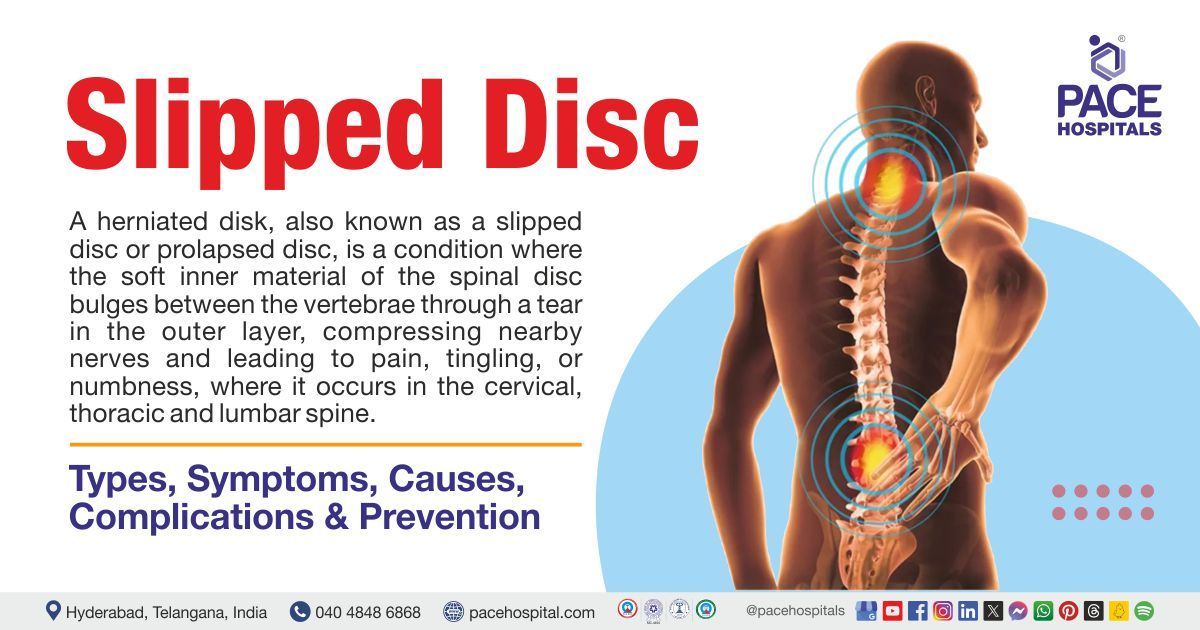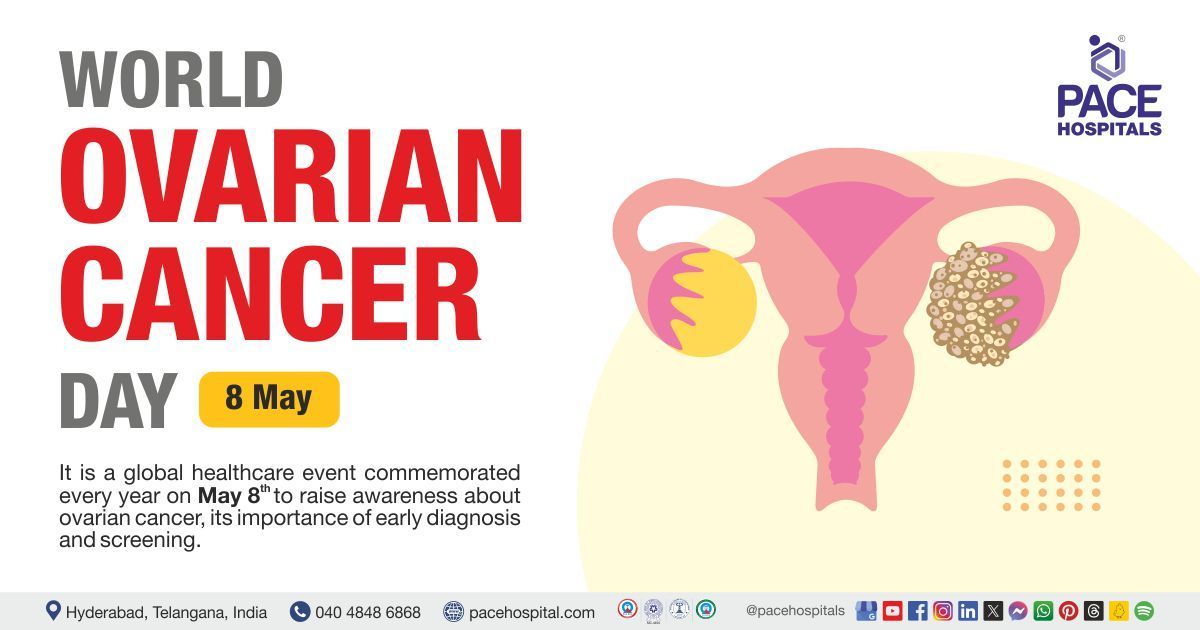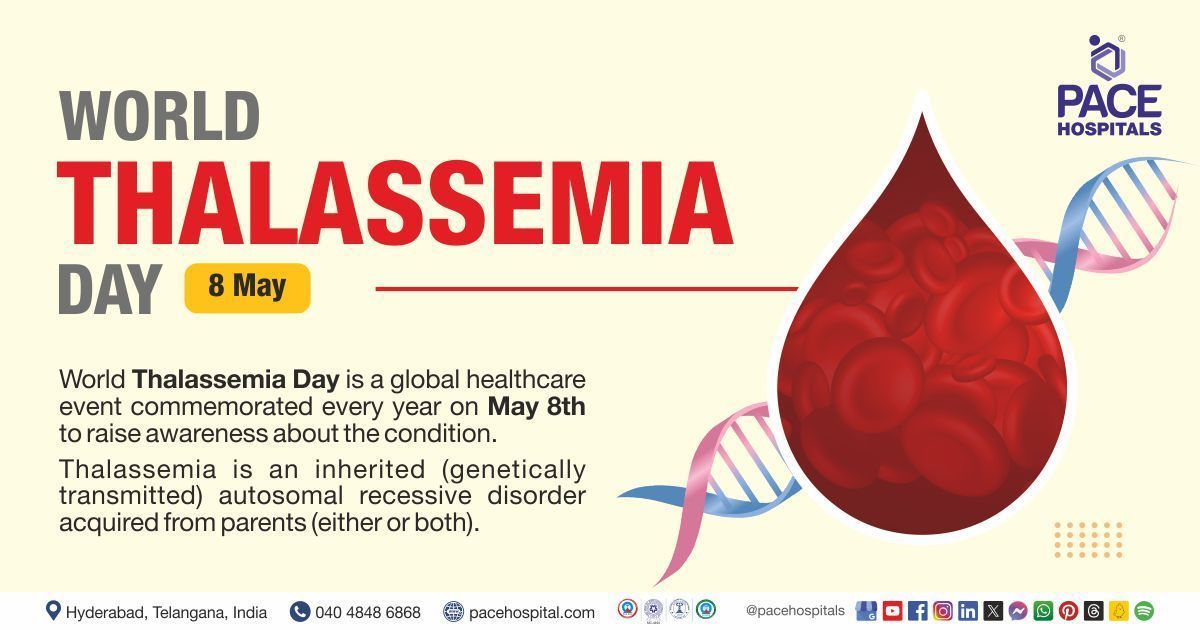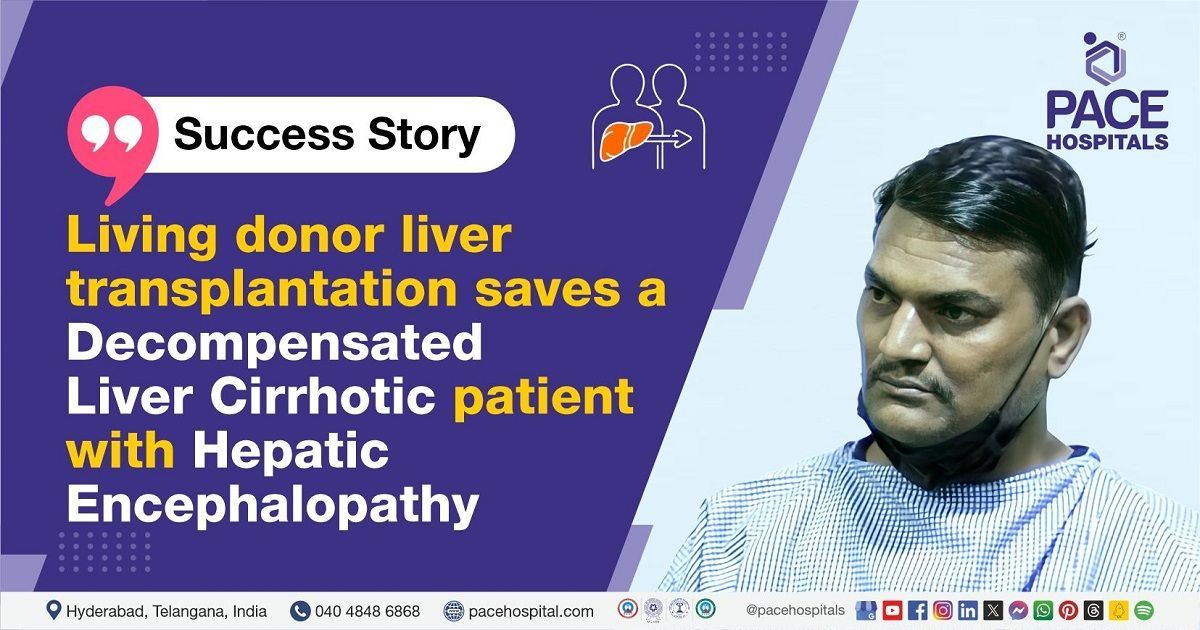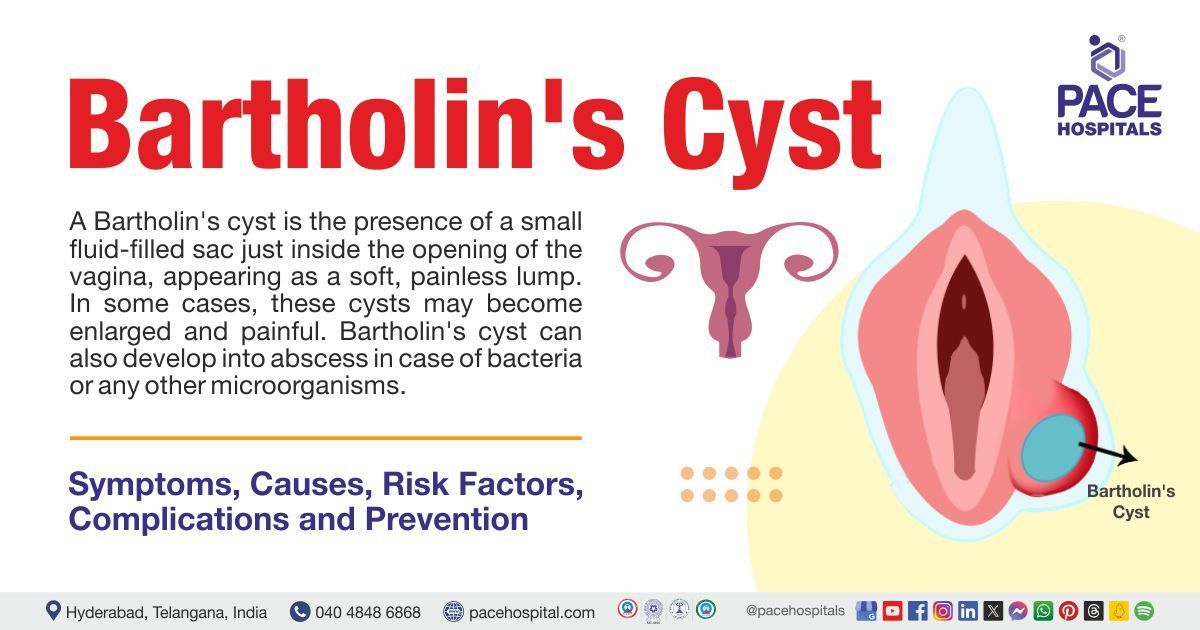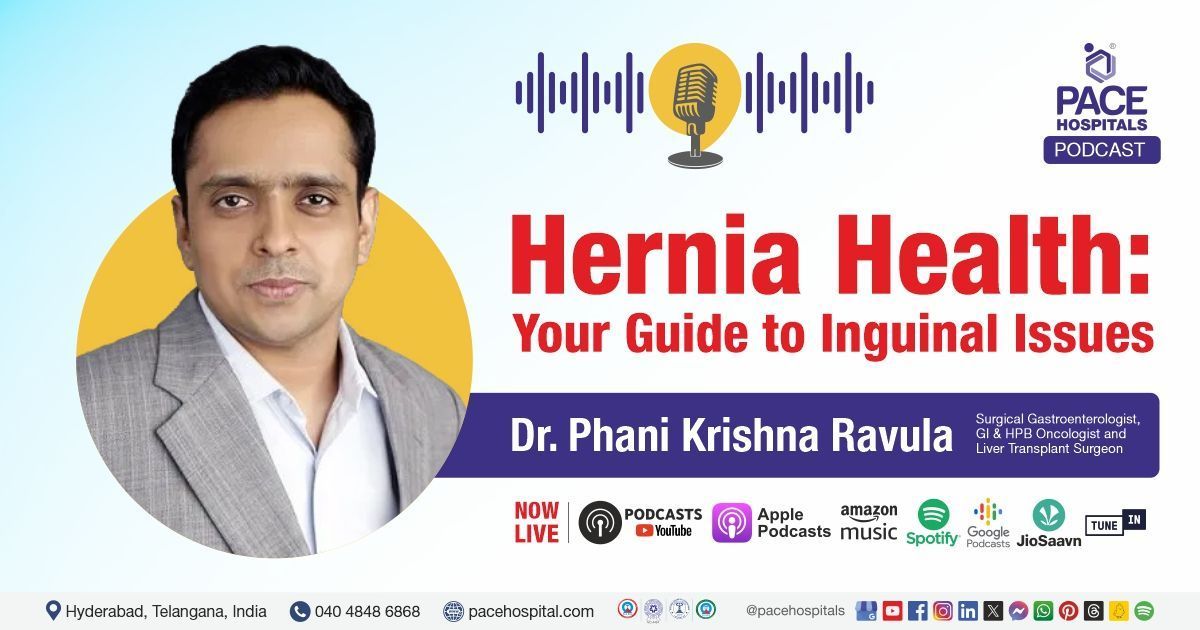Deep Vein Thrombosis, DVT - Symptoms, Causes, Types, Complications and Prevention
DVT full form in medical - Deep Vein Thrombosis
A blood clot is called a "thrombus," while several blood clots are called "thrombi". Deep vein thrombosis (DVT) is the occurrence of one or more blood clots in one of the body's principal veins, mostly in the lower limbs (such as, the lower leg or calf).
The clots may completely or partially restrict blood flow in the vein, which may cause some patients to experience pain, swelling, discomfort, discolouration, or redness in the affected area and possibly warm-to-the-touch skin. It can be dangerous if the clot breaks off and travels to the lungs, where it can cause a pulmonary embolism (PE).
Incidence of DVT (Deep Vein Thrombosis)
The lower limb is often impacted by deep vein thrombosis (DVT), with clot development occurring in a deep calf vein and spreading proximally. It is a common venous thromboembolic disorder (VTE) with an annual incidence of over 1.6 per 1000 people.
Distal veins are responsible for 40% of site involvement, followed by popliteal 16%, femoral 20%, common femoral 20%, and iliac veins 4%. Less than 10% of DVTs occur in the upper limbs, and central vein catheters are the primary risk factor.
Venocaval thromboses (clots in the vena cava) are relatively rare and connected to vascular abnormalities, compression, and cancer.
Types of DVT (Deep Vein Thrombosis)
There are two main types of deep vein thrombosis (DVT), they are as follows::
- Acute DVT (acute deep vein thrombosis)
- Chronic DVT (chronic deep vein thrombosis)
Acute DVT: Acute deep vein thrombosis can develop in men and women of all ages, especially in the legs. It can make walking difficult, swells and hurts the legs. The number of veins injured, and the severity of the symptoms, increase with the size of the blood clot.
Chronic DVT: "Chronic" refers to more than one to two months old clots. The vein becomes scarred when the clot hardens, and it causes the vein to shrink significantly, making it difficult for blood to flow through.
There are also several other types of deep vein thrombosis (DVT), including:
- Travel-Associated DVT: This type of DVT occurs in people who have been sitting for long periods of time, such as on long flights or car rides.
- Postpartum DVT: This type of DVT occurs in women within three months of giving birth.
- Immobilization DVT: This type of DVT occurs in people who are unable to move around much, such as after surgery or a major injury.
- Inherited DVT: This type of DVT is caused by a genetic disorder that makes people more likely to form blood clots.
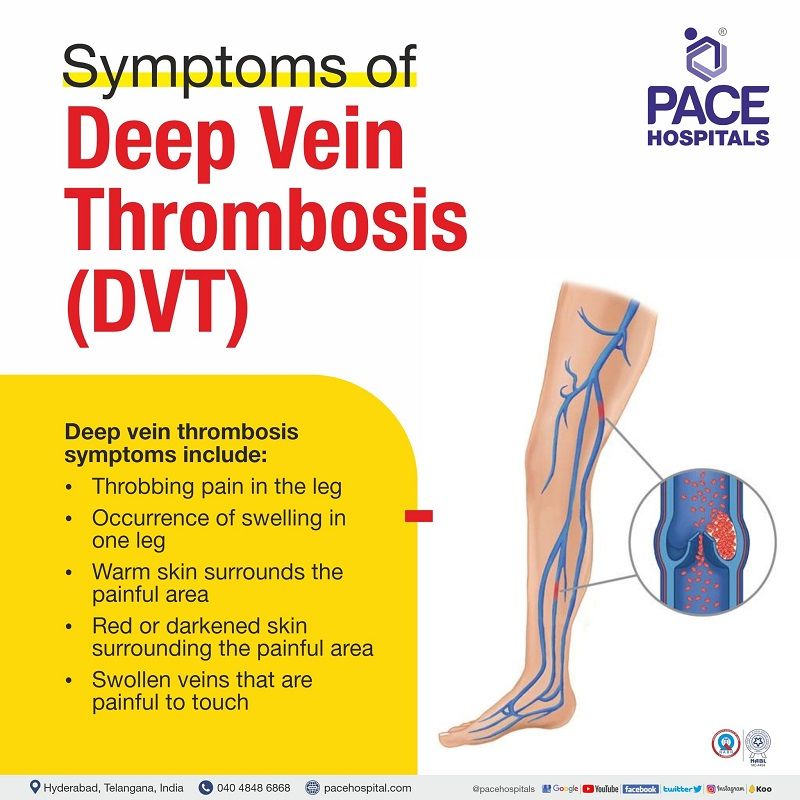
Deep Vein Thrombosis - DVT symptoms
DVT disease can be a serious condition, but it is usually treatable with proper medication and regular checkups. These are some of the symptoms of deep vein thrombosis (DVT):
- Throbbing (to beat or pulsate with increased force) pain in the leg
- Occurrence of swelling in one leg (rarely in both legs)
- Warm skin surrounds the painful area
- Red or darkened skin surrounding the painful area (sometimes, it may not be visible in individuals with black or brown skin)
- Swollen veins that are painful to touch
If the patient is experiencing breathlessness (dyspnoea), chest pain along with the above symptoms, then the condition is to be taken as an emergency and needs to consult the doctor immediately. This condition is called pulmonary embolism (PE).
Pulmonary embolism (PE) is a condition where the portion of a blood clot in DVT passes through the bloodstream to the lungs. People can recover from this condition if the clot is small, and the proper treatment is received.
If a bigger clot dislodges and obstructs the blood from reaching the lungs, it may lead to death finally. Pulmonary embolism (PE) may cause:
- Trouble while breathing
- Arrhythmia (irregular heartbeats)
- Angina (chest pain when taking a deep breath)
- Haemoptysis (coughing up blood)
- Low blood pressure
- Dizziness (light-headedness or fainting)
Note: One-third of people who get a DVT will suffer long-term health issues called post-thrombotic syndrome (PTS). PTS can lead to oedema, discomfort, skin discolouration or redness, and other problems. It allows the skin more vulnerable to cellulitis, an infection that can enter the circulation and result in sepsis and death.
DVT (blood clot in a vein) typically does not cause a heart attack or stroke. Usually, the body receives oxygen-rich blood from the heart through arteries. Heart attacks and strokes can be brought on by arterial thrombosis, a blood clot in an artery.
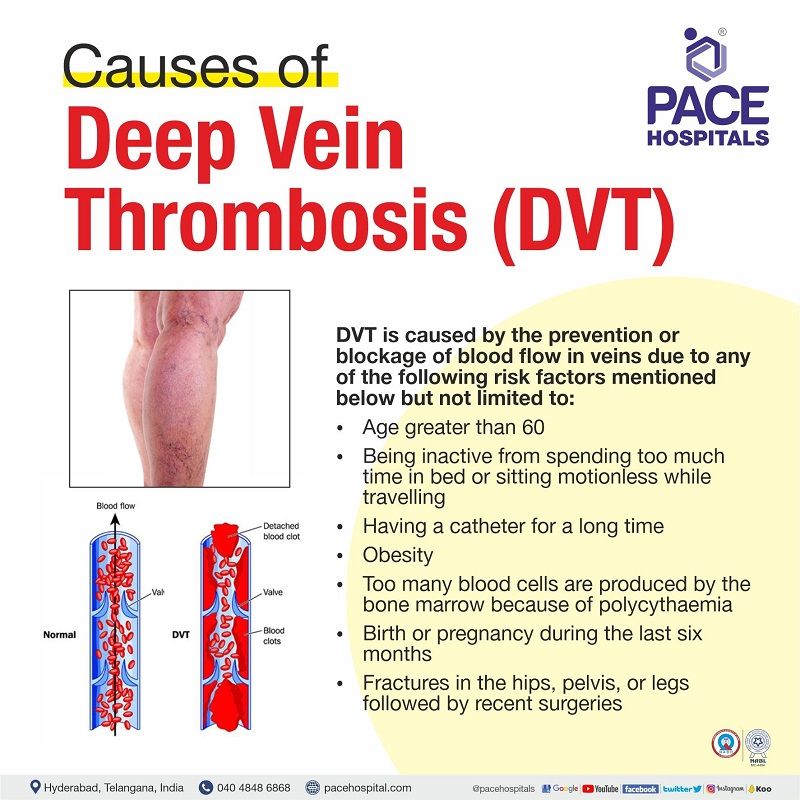
Deep Vein Thrombosis - DVT causes
DVT meaning
DVT (Deep Vein Thrombosis) is caused by the prevention or blockage of blood flow in veins due to any of the following risk factors mentioned below, but not limited to:
- Age greater than 60
- Being inactive from spending too much time in bed or sitting motionless while travelling
- Having a catheter for a long time
- Obesity
- Too many blood cells are produced by the bone marrow because of polycythaemia
- Birth or pregnancy during the last six months
- Fractures in the hips, pelvis, or legs followed by recent surgeries
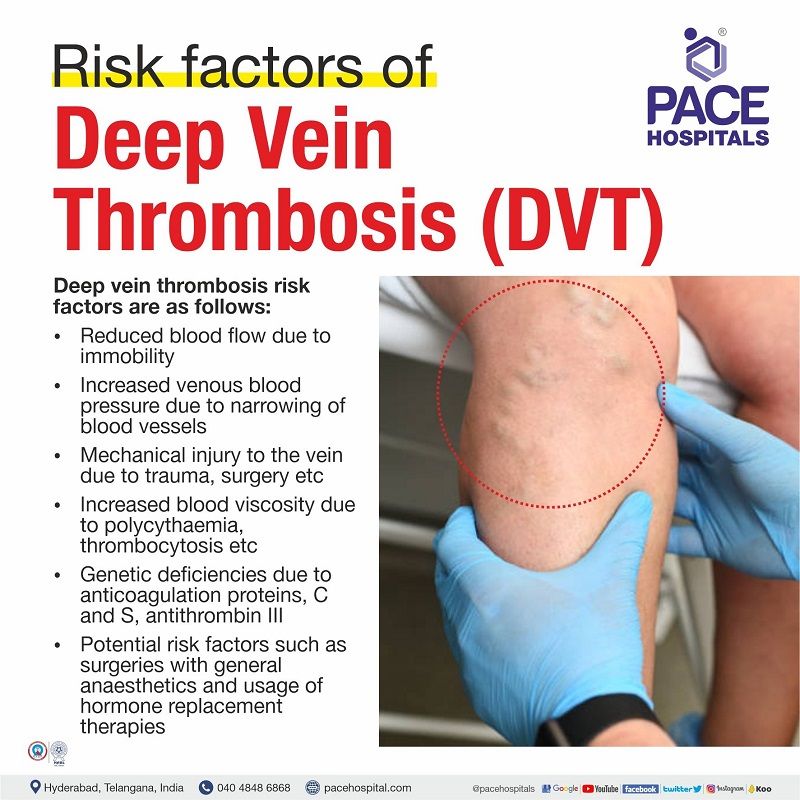
Deep Vein Thrombosis - DVT risk factors
DVT (Deep Vein Thrombosis) risk factors are classified as follows:
- General risk factors
- Risk factors associated with coagulation
- Constitutional risk factors
- Potential risk factors
General risk factors
- Reduced blood flow due to immobility because of Operations, General anaesthesia, Bed rests, Stroke or Long flights
- Increased venous blood pressure due to mechanical compression and functional impairment because of Stenosis (narrowing or constriction of the passage), Congenital anomaly (abnormal foetal changes) or Neoplasm (abnormal growth of the tissue) or Pregnancy
- Mechanical injury to the vein due to Peripherally inserted venous catheters, Trauma (injury), Surgery, Previous DVT disease or Intravenous drug abuse
- Increased blood viscosity due to Polycythaemia rubra vera (bone marrow produces too many blood cells), Thrombocytosis (producing too many platelets by the body) or Dehydration
- Anatomic changes in the veins may lead to thrombosis.
Risk factors associated with coagulation
- Genetic deficiencies due to Anticoagulation proteins C and S (glycoproteins responsible for clotting), Deficiency of Antithrombin III (clotting factor) or Factor V Leiden mutation (clotting factor)
- Acquired risks due to Vasculitis (inflammation of blood vessels), Systemic lupus erythematosus (autoimmune inflammatory disease), Altered lupus anticoagulant (immunoglobulins), Inflammatory bowel disease (digestive tract inflammation), Nephrotic syndrome (too much protein excreted by the kidney), Cancer, Sepsis (life-threatening infection), Myocardial infarction (heart attack), Heart failure, Hypertension, Diabetes, Burns, Oral oestrogens, Smoking
Constitutional risk factors: Surgery, Critical care admission, Dehydration, Cancer, Obesity, Pregnancy, Age greater than 60
Potential risk factors:
Surgery with general anaesthetics, Hospitalisation, Caesarean section (birth procedure of baby through womb), Hormone replacement therapy, Pregnancy and peripartum period (shortly before or during, or immediately after the birth), Lower extremity injury with limited mobility for more than 72 hours
Deep Vein Thrombosis - DVT complications
Deep vein thrombosis complications are as follows:
- Bleeding from the use of anticoagulants
- Pulmonary embolism (arteries in the lungs become blocked)
- Post-thrombotic syndrome
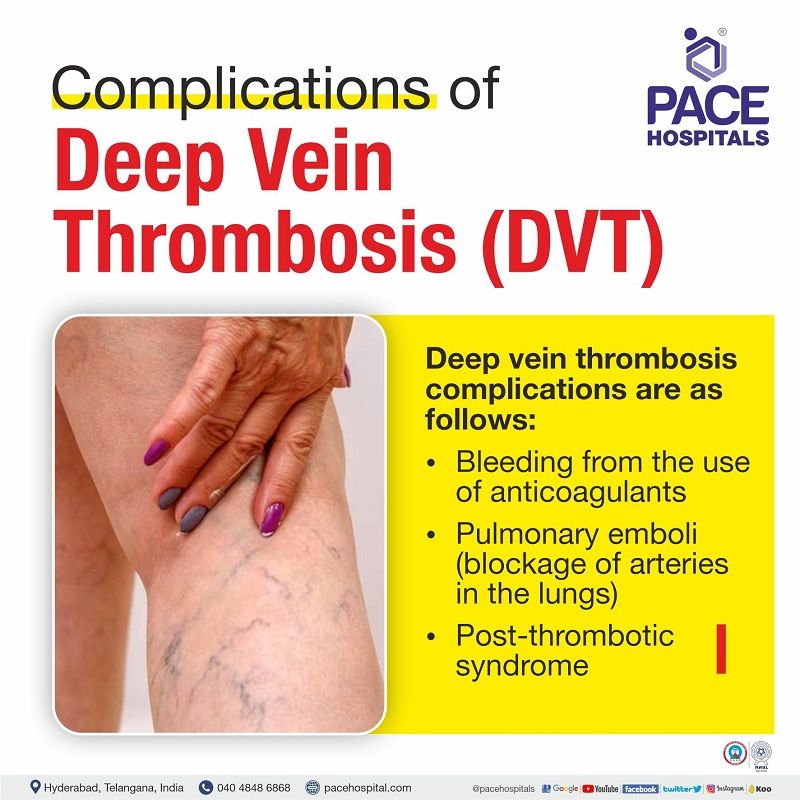
Deep Vein Thrombosis - DVT stages
The following categories describe the disease's severity:
- Provoked: As a result of acquired conditions (such as cancer, oral contraceptives, trauma, immobility, and obesity)
- Unprovoked: Due to endogenous or idiopathic (unknown) causes, there is a higher risk of recurrence if anticoagulation discontinues.
- Proximal: Over the knee, impacting the iliofemoral or femoral veins; far more prone to cause consequences such as pulmonary emboli.
- Distal: below the knee.
Deep Vein Thrombosis - DVT prognosis
Many DVTs will clear up without any problems.
- Two years after a DVT, 43% of patients had post-thrombotic syndrome (mild: 30%; moderate:10%; severe: 3%).
- DVT recurrence is highly probable (up to 25%).
- About 6% of DVT cases and 12% of pulmonary embolism (PE) cases end in death within a month of diagnosis.
- Early death after venous thromboembolism significantly correlates with advanced age, malignancy, underlying cardiovascular disease, and pulmonary embolism presentation.
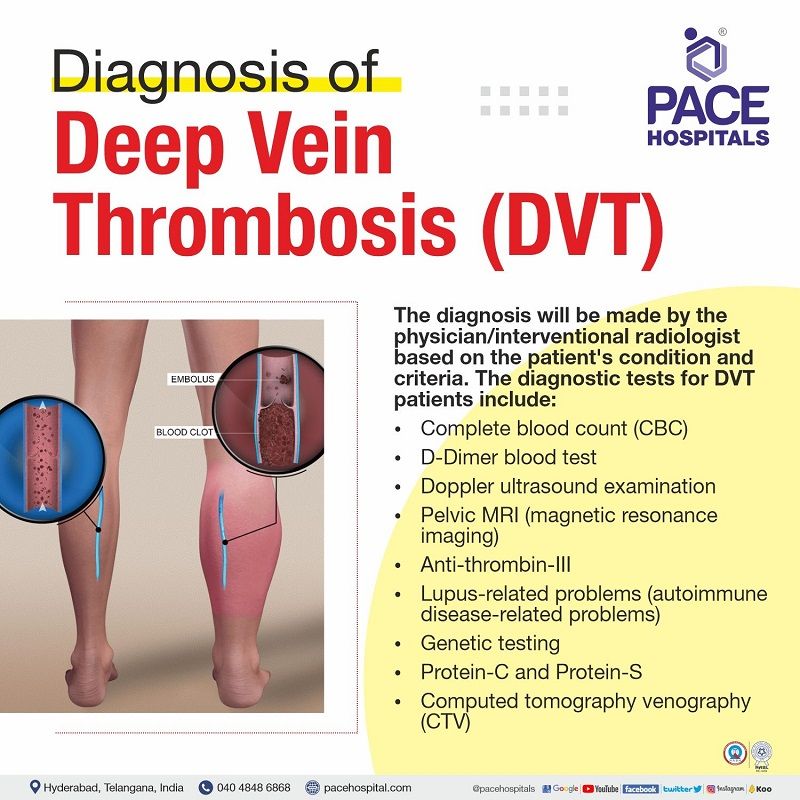
Deep Vein Thrombosis - DVT diagnosis
Whenever the patient visits the hospital, the interventional radiologist usually takes the patient's history and symptoms and then suggests an ultrasound exam within 24 hours.
The physician/interventional radiologist does a physical exam to know which symptoms were probably causing the DVT disease.
Physical examination
- Limb oedema may be unilateral or bilateral if the thrombus moves to the pelvic veins.
- Having dilated veins with red and hot skin.
- Tenderness (difficult to touch due to pain).
The physician/interventional radiologist takes the history regarding.
- Pain (usually seen in 50% of patients)
- Redness
- Swelling (usually seen in 70% of patients)
The diagnosis and vascular testing include
- Doppler's ultrasound exam
- Pelvic MRI (magnetic resonance imaging)
- Complete blood count (CBC)
- D-dimer blood test (deep vein thrombosis test)
- Genetic testing
- Levels of protein C and protein S
- Antithrombin III levels
- Lupus-related problems
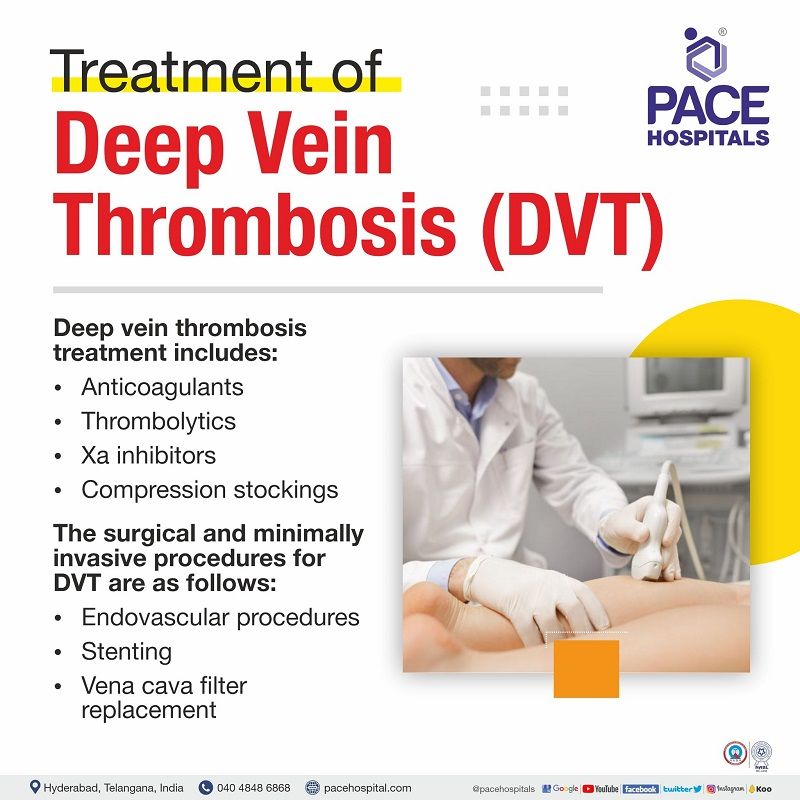
Deep Vein Thrombosis - DVT treatment
The first line of treatment for DVT (Deep Vein Thrombosis) includes:
- Blood thinning agents
- Direct oral anticoagulants
- Ⅹa inhibitors
In rare cases, physician/interventional radiologist suggest surgeries in addition to the first-line treatment. The surgery procedures used to treat deep vein thrombosis are:
- Endovascular procedures
- Stenting
- Vena cava filter placement
DVT prevention and lifestyle modifications
Deep vein thrombosis prevention includes the following measures, such as:
- Maintaining a healthy weight
- Keep moving; regular walks can help
- DVT disease is more common if dehydrated, drinking plenty of fluids is recommendable
- Stay motionless for a short time; get up and walk about every hour or so
- Avoid crossing legs while sitting
- Avoid smoking
- Don't consume alcohol; alcohol should be avoided
Deep vein thrombosis post-surgery precautions:
- When seated, keep the affected leg upwards
- Delay taking any long trips or flights for at least two weeks after you begin taking blood thinners
- If there is a must and should stay in bed for a long time, healthcare workers suggest rotating the ankles and toes in an upward and downward direction so that blood circulation will be done freely
- Using elastic or compression socks (DVT socks) improves blood circulation
- Continue the medications as prescribed by the doctor to prevent further complications
- In case of emergency or urgency, seek medical attention immediately
- Maintain regular follow-ups or appointments
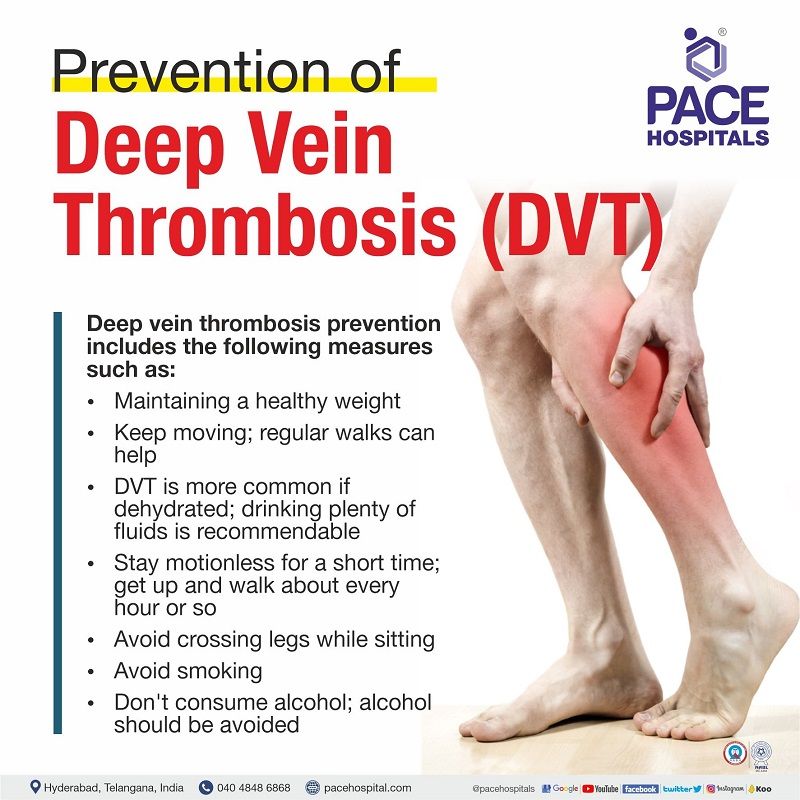
Difference between DVT and Varicose veins
Deep vein thrombosis vs varicose veins
Deep vein thrombosis (DVT) and varicose veins are two distinct vascular conditions that affect the veins in the body, but they have different causes, symptoms, and potential complications.
| Parameter | Varicose veins | DVT (Deep vein thrombosis) |
|---|---|---|
| Overview | In this varicose veins condition, veins are enlarged and twisted anywhere in the body but are quite common in the legs. | In DVT condition, clots are formed in the large veins, mostly in the lower limbs. |
| Causes | Increased blood pressure in the veins, Injury or damage to the veins, Being in a state of motionless for a long time | Injury or trauma to the principal veins, Inflammation or infection of the skin |
| Risk factors | Leg injury, Pregnancy, Smoking, Taking oral contraceptive pills or hormone replacement, Overweight or obesity, Older age, Being female, Being inactive | Injury, Obesity, Age greater than 60, Being motionless for a long time, Pregnancy, Dehydration, Hormone replacement therapies, Inserting venous catheters |
| Symptoms | Colour changes in the skin, Sores on the legs, Rash, A feeling of heaviness and a burning sensation in legs | Throbbing pain in legs, Swelling in one or both the legs, Swollen veins, Red or darkened skin around the infected area, Warm skin in the pain region |
| Complications | Phlebitis (inflammation or swelling of the veins), Blood clots | Pulmonary embolism, Post-thrombotic syndrome, Bleeding |
| Diagnosis | Duplex ultrasound | Complete blood count (CBC), D-dimer blood test, Doppler ultrasound exam, Pelvic MRI, Antithrombin III levels, Lupus-related problems, Genetic testing, Levels of protein C and protein S |
| Treatment | Compression stockings, Sclerotherapy, Thermal ablation, Vein stripping, Microphlebectomy | Endovascular procedures, Stenting, Vena cava filter placement, Thrombolytic agents and blood thinning agents, Direct oral anticoagulants, Ⅹa inhibitors |
FAQs (frequently asked questions on DVT)
-
How to avoid deep vein thrombosis (DVT)?
If there is a possibility for DVT. DVT can be prevented by using elastic or compression stockings (DVT stockings), which may improve blood circulation to the veins; walking also improves blood circulation to the veins.
Apart from these, several factors play a major role in avoiding DVT, such as maintaining a healthy weight, being hydrated, avoiding motionless postures, and doing exercises suggested by the medical staff to prevent reoccurrence.
-
How serious is deep vein thrombosis (DVT)?
DVT - deep vein thrombosis definition
Deep vein thrombosis (DVT) is a serious medical condition that can be life-threatening. It occurs when a blood clot forms in a vein deep in the body, typically in the legs. The clot can break off and travel to the lungs, where it can cause a pulmonary embolism (PE). A PE is a blockage in an artery in the lung, which can cause shortness of breath, chest pain, and even death.
The severity of DVT depends on a number of factors, including the size of the clot, the location of the clot, and whether or not the clot has broken off and traveled to the lungs. Small clots that do not break off may not cause any symptoms and may resolve on their own. However, larger clots that break off and travel to the lungs can be very serious and even fatal.
If you think you may have DVT, it is important to see a doctor right away. DVT can be treated with blood thinners, which help to prevent the clot from getting bigger or breaking off. Early diagnosis and treatment can help to prevent complications, such as PE.
-
Can deep vein thrombosis (DVT) cure itself?
It may cure itself without noticing the symptoms in most of the conditions. Usually, a blood clot develops in one of the bigger, deeper veins that pass through the muscles. Lower leg deep vein thrombosis condition occurs most commonly.
In most of cases, the clots frequently disappear on its own without being treated. However, it could result in signs like discomfort and oedema. If DVT is identified with the mentioned symptoms, therapy is necessary to prevent serious complications such as pulmonary embolism. This could happen if the blood clot breaks up from its original location and travels via the bloodstream to the lungs.
-
Is there a permanent cure for deep vein thrombosis (DVT)?
There are no studies established that there is a permanent cure for DVT. In most conditions, minor clots may resolve themselves without showing symptoms, and it is suggested for treatment whenever the symptoms, such as swelling and inflammation, are noticed.
Usually, there are some surgeries to resolve the DVT conditions, such as endovascular procedures, stenting, and usage of blood thinners. However, there is a chance of reoccurrence of DVT after surgery due to sedentary lifestyles, obesity, and being motionless for longer times.
-
Is deep vein thrombosis (DVT) hereditary?
Yes, it may be caused due to genetic deficiencies such as anticoagulation proteins C and S, antithrombin III deficiency, and Factor V Leiden mutation.
-
What are the warning signs of deep vein thrombosis (DVT)?
The warning signs of DVT are trouble breathing, haemoptysis (coughing up blood), low blood pressure, dizziness (light-headedness or fainting), arrhythmia (irregular heartbeats), and angina (chest pain when taking a deep breath). Suppose the patients have experienced the mentioned symptoms. In that case, they must seek emergency medical attention to avoid complications such as pulmonary embolism (obstructing the blood from reaching the lungs).
-
How do you treat deep vein thrombosis (DVT)?
The first treatment choice for DVT (deep vein thrombosis medication) is anticoagulants (blood thinners). They prevent clot formation and allow blood supply to the lungs to avoid complications. Despite this, few surgical procedures are recommended based on the severity of the condition. The surgical and invasive procedures for DVT are endovascular procedures, stenting, and vena cava filter placement.
-
What can be confused with DVT?
The conditions that are similar or confused with DVT are cellulitis, post-thrombotic syndrome (especially venous eczema and lipodermatosclerosis), venous or lymphatic obstruction, arteriovenous fistula, congenital vascular abnormalities, vasculitis, ruptured baker cyst, trauma, superficial thrombophlebitis, peripheral oedema, heart failure, cirrhosis, nephrotic syndrome.
-
How to prevent deep vein thrombosis when flying?
The size and layout of aeroplane cabins make it increasingly difficult to move up and down the aisles to keep the blood flowing (DVT exercise). From the seat, the patient can perform calf workouts. Stretching and calf lifts are crucial. Many airlines include a leaflet in their magazine that demonstrates these mobility exercises and is effective. It increases circulation.
Don't put anything beneath the seat in front of a person, which is another important piece of advice. Only travel with a little luggage. Everything should be placed in the overhead bin for flexibility. The best tools we have on long trips are exercising and staying hydrated.
-
Who treats deep vein thrombosis (DVT)?
The physician will focus on the treatment and medications for DVT, whereas the surgeries will be done by the vascular surgeon or vascular specialists (Interventional radiologist).
Request an appointment
Fill in the appointment form or call us instantly to book a confirmed appointment with our super specialist at 04048486868
Appointment request - health articles
Thank you for contacting us. We will get back to you as soon as possible. Kindly save these contact details in your contacts to receive calls and messages:-
Appointment Desk: 04048486868
Whatsapp: 8977889778
Regards,
Pace Hospitals
Hitech City and Madinaguda
Hyderabad, Telangana, India.
Oops, there was an error sending your message. Please try again later. We will get back to you as soon as possible. Kindly save these contact details in your contacts to receive calls and messages:-
Appointment Desk: 04048486868
Whatsapp: 8977889778
Regards,
Pace Hospitals
Hitech City and Madinaguda
Hyderabad, Telangana, India.
Our Locations
Subscribe to our newsletter and stay updated with the latest health information.
By clicking on subscribe now, you accept to receive communications from PACE Hospitals on email, SMS and Whatsapp.
Subscribe to PACE Hospitals News
Thank you for subscribing. Stay updated with the latest health information.
Oops, there was an error. Please try again submitting your details.
-

Payment in advance for treatment (Pay in Indian Rupees)
For Bank Transfer:-
Bank Name: HDFC
Company Name: Pace Hospitals
A/c No.50200028705218
IFSC Code: HDFC0000545
Bank Name: STATE BANK OF INDIA
Company Name: Pace Hospitals
A/c No.62206858997
IFSC Code: SBIN0020299
Scan QR Code by Any Payment App (GPay, Paytm, Phonepe, BHIM, Bank Apps, Amazon, Airtel, Truecaller, Idea, Whatsapp etc)
Call us at 04048486868
ADDRESS
PACE Hospitals
Hitech City : Beside Avasa Hotel, Pillar No. 18, Hyderabad - 500081
Madinaguda: Mythri Nagar, Beside South India Shopping, Madinaguda, Hyderabad - 500050
QUICK LINKS
Disclaimer
General information on healthcare issues is made available by PACE Hospitals through this website (www.pacehospital.com), as well as its other websites and branded social media pages. The text, videos, illustrations, photographs, quoted information, and other materials found on these websites (here by collectively referred to as "Content") are offered for informational purposes only and is neither exhaustive nor complete. Prior to forming a decision in regard to your health, consult your doctor or any another healthcare professional. PACE Hospitals does not have an obligation to update or modify the "Content" or to explain or resolve any inconsistencies therein.
The "Content" from the website of PACE Hospitals or from its branded social media pages might include any adult explicit "Content" which is deemed exclusively medical or health-related and not otherwise. Publishing material or making references to specific sources, such as to any particular therapies, goods, drugs, practises, doctors, nurses, other healthcare professionals, diagnoses or procedures is done purely for informational purposes and does not reflect any endorsement by PACE Hospitals as such.

